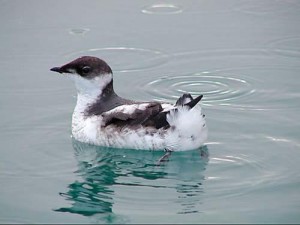forum
library
tutorial
contact

Proposed Wind Farm in Washington's
Most Important Marbled Murrelet Area Scrubbed
by Staff
Surfbirds News, December 10, 2011
|
the film forum library tutorial contact |

|
Proposed Wind Farm in Washington's
by Staff
|
 Plans to build a 32-turbine wind farm near the coast of Washington in a key breeding area for a threatened seabird have been halted to the relief of conservationists.
Plans to build a 32-turbine wind farm near the coast of Washington in a key breeding area for a threatened seabird have been halted to the relief of conservationists.
The decision by Energy Northwest and three public utility districts was based on a softening of the wind power market and likely wind farm operating conditions that might have been suggested by the U.S. Fish and Wildlife Service (FWS) to ensure protection of the Marbled Murrelet - a bird whose population continues to decline despite being listed since 1992 as threatened under the Endangered Species Act.
Marbled Murrelets live at sea but nest inland in mature forests where they lay a single egg and raise one chick per year. Each day, starting before dawn and continuing until after sunset, they make multiple trips between the ocean and the nest to feed the chick with freshly-caught small fish. Loss of either parent typically means the loss of both the parent bird and the chick, as well as the loss of a breeding season. Marbled Murrelet numbers along the west coast of the lower 48 states have been declining at the rate of about four per cent per year for the last decade, about seven per cent per year in Washington where the project was proposed.
The USFWS and proponents of the project were in the early stages of developing a Draft Environmental Impact Statement for the project, a preliminary step in seeking an Incidental Take Permit under the ESA, when the proponents decided to stop the process, citing concerns about a soft market for wind energy and possible conditions for the permit. Although they had suggested a 36-40 year permit, the USFWS was considering suggesting a five-year interim permit to allow the proponents to gather more data on how they might protect murrelets from impacts from the project and to monitor the effects of the facility as it operated. Based on the information gathered, the USFWS would then have considered a longer permit. Other ideas under consideration were proposals to shut down the turbines, whose blades can move at up to 200 MPH, during prime murrelet passage hours, to install bird monitoring technology on the turbines and to establish a mitigation fund for possible bird strikes. The suggested modifications could have been part of an Enhanced Conservation Alternative advanced for public comment through the NEPA process. The proponents chose to stop the process before that happened.
"The Fish and Wildlife Service did the right thing. They warned the developers that there would be serious obstacles to siting a wind farm in extremely sensitive bird habitat. They proposed a series of conservation measures that would be needed to protect a federally-listed threatened bird. This was predictable and shouldn't have surprised anyone. Our congratulations to Seattle Audubon for their leadership in raising awareness about this threat and effective advocacy for murrelet protection." said Darin Schroeder, Vice President for Conservation Advocacy for American Bird Conservancy, the nation's leading bird conservation organization.
The 80 megawatt Washington wind farm would have been located in Pacific County, in the southwest part of the state, and would have directly impacted a narrow swath more than four miles long. The turbines would have extended to a height of about 430 feet from base to turbine tip in a ridged area with an elevation ranging between 1,000 and 1,900 feet.
While there was no mature or old growth forest in the footprint of the proposed project, there are 89 occupied Marbled Murrelet nests within 30 miles inland. Some of these birds would have had to fly through the wind farm area to go between nesting and foraging areas. Further, the northwest end of the project is within 1,800 feet of the border of the South Nemah Natural Resources Conservation Area, which features the highest nesting concentration of Marbled Murrelets in the state. These birds would have been at risk from the wind farm.
Marbled Murrelets occur from the Aleutians and the southern coast of Alaska south to northern California. Their populations have declined by about 30 percent in their primary habitat of Oregon, Washington and Northern California. The bird is now rare or uncommon along the Pacific Coast of the United States, where it was common or abundant in the early 20th Century. Populations have also declined severely in the northern Gulf of Alaska, though this remains the stronghold of the species, with up to 90% of the total North American numbers found there. Conservation of the coastal forests where it breeds is the most essential step to protecting the species, but limiting the use of gill-nets that can kill murrelets as they dive for fish, and prevention and containment of oil spills are both important for its continued survival.
"ABC believes that wind power can be a productive form of green energy when it conforms to bird-smart principles. The number one principle is careful siting of wind projects, and this particular wind farm would have clearly failed to meet that criterion," Schroeder said.
learn more on topics covered in the film
see the video
read the script
learn the songs
discussion forum
